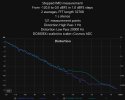RME's ESS based ADI-2's have cleaner output with PCM353kHz (44.1kHz x 8) than original 44.1kHz, in my measurement with Cosmos ADC + REW
Innomaker DAC PRO HAT for RPi4 also (another ESS based).
Yes, and you can measure that without upscaling, since RME
bypasses (edit: some RME devices with AKM chip insert slower roll-off filter at higher sampling rates) changes the digital filter at higher sampling rates.
There is no difference between an upsampled signal and the same signal generated directly at the desired sample rate, except for any artifacts that a poor upsampling algorithm might produce. The DAC doesn't react differently to input that's upsampled or naturally generated (or recorded) at that rate.
I think I know where this comes from (HQPlayer by any chance?) But the difference there is that the comparison is between the DAC doing the upsampling or HQP doing it, with material that's generated or recorded
at lower sample rates.
In MTA, the PCM est signal is generated precisely at the desired rate, so there's no need to upsample it You want to test what the DAC does at 768k? Just set the desired output rate to 768k and press the record button. The test signal will be "natively" generated at 768k. There's no upsampling involved or needed at the DAC or in MTA. If your DAC turns off digital filter at 768k, like RME does, then it will be turned off with the "naturally" generated MTA test signal at the input.

